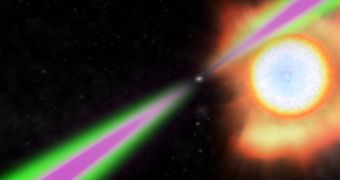A new, large-scale study of black widow and redback star systems has revealed one possible explanation for how solitary millisecond pulsars form. According to observations carried out using the NASA Fermi Gamma-ray Space Telescope's Large Area Telescope (LAT), these objects may form after they consume their former binary star system companions.
Here on Earth, both black widow and redback spiders are known for devouring their partners. A similar situation occurs in binary systems that feature neutron stars, or special types of neutron stars, such as pulsars or magnetars. These are the types of systems Fermi focused on in the new study.
These systems share some commonalities, such as the fact that they both place a small star in close proximity to a pulsar. The latter is a special type of neutron star that spins very fast around its axis, all while releasing massive amounts of radiations in multiple portions of the electromagnetic spectrum.
All types of neutron stars form through the collapse of a massive star that is not heavy enough to form a black hole. A standard star of this type compresses the mass of the Sun in an object just dozens of kilometers across, resulting in a huge density value. A single teaspoon of material from a neutron star is estimated to weigh as much as the Himalayas.
Redback binaries tend to feature larger and more massive stars around their pulsars than black widow systems, but the consequences are similar. The Milky Way has thus far revealed 18 black widow and 9 redback systems, but the search is still on, researchers say, especially in the globular clusters orbiting our galaxy.
The new study was led by investigator Roger Romani, who is based at the Kavli Institute for Particle Astrophysics and Cosmology. The organization is a joint effort by Stanford University and the SLAC National Accelerator Laboratory.
By studying the black widow binary system PSR J1311-3430 – which was first identified back in 2012 – scientists found out that “the high-energy emission and wind from the pulsar basically heats and blows off the normal star's material and, over millions to billions of years, can eat away the entire star,” says Alice Harding.
“These systems can completely consume their companion stars, and that's how we think solitary millisecond pulsars form,” adds the expert, who holds an appointment as an astrophysicist at the NASA Goddard Space Flight Center (GSFC) in Greenbelt, Maryland.
Unlike regular pulsars, the millisecond variant spins around its own axis thousands of times per minute. Some of these objects complete a full spin around their axis once every 10 milliseconds, hence their names. Oftentimes, they are found alone, without any companions, and scientists now think that this is because they consume their partners soon after the binary systems form.

 14 DAY TRIAL //
14 DAY TRIAL //